Health and Social Care Level 3: Infection Control, Diet, Handling and Moving, Challenging Behavior, and Medicine Handling
VerifiedAdded on 2023/06/03
|8
|1744
|257
AI Summary
This article discusses the principles of infection control, good diet, handling and moving techniques, managing challenging behavior, and good practice when handling medicine in Health and Social Care Level 3. It covers personal hygiene, isolation, and legal regulations for infection control, constituents of a good diet, principles of handling and moving, techniques for managing challenging behavior, and good practice for handling medicine.
Contribute Materials
Your contribution can guide someone’s learning journey. Share your
documents today.
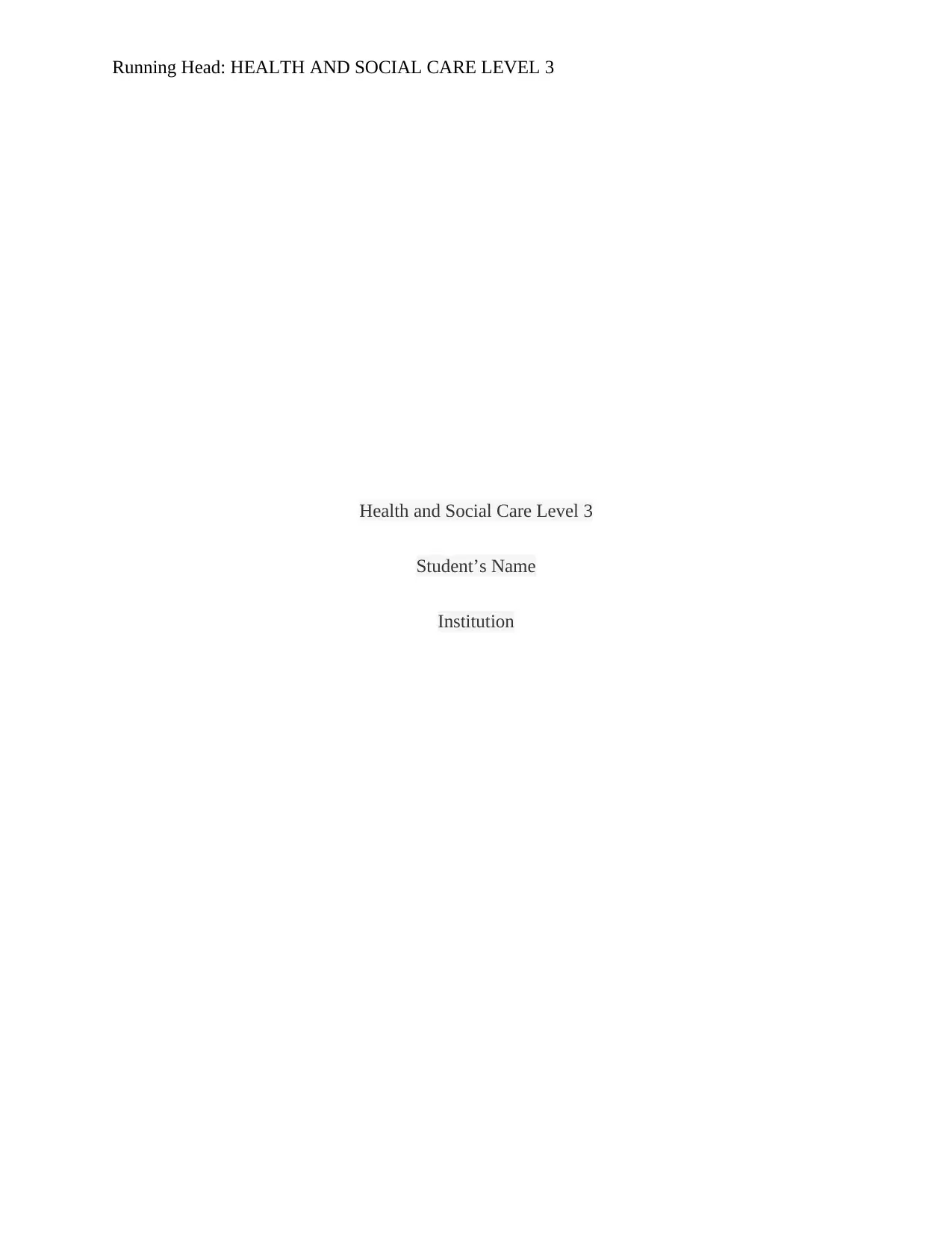
Running Head: HEALTH AND SOCIAL CARE LEVEL 3
Health and Social Care Level 3
Student’s Name
Institution
Health and Social Care Level 3
Student’s Name
Institution
Secure Best Marks with AI Grader
Need help grading? Try our AI Grader for instant feedback on your assignments.
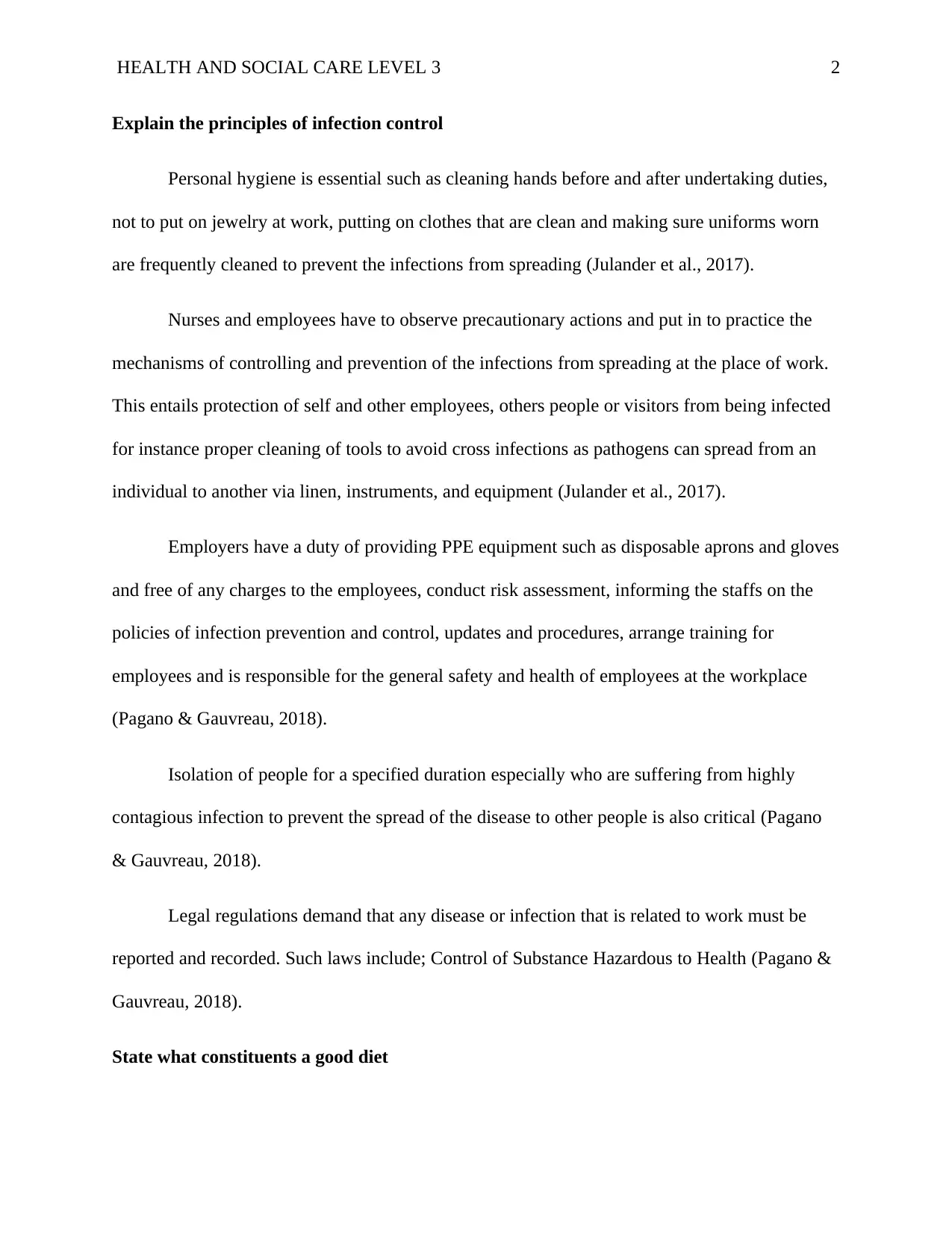
HEALTH AND SOCIAL CARE LEVEL 3 2
Explain the principles of infection control
Personal hygiene is essential such as cleaning hands before and after undertaking duties,
not to put on jewelry at work, putting on clothes that are clean and making sure uniforms worn
are frequently cleaned to prevent the infections from spreading (Julander et al., 2017).
Nurses and employees have to observe precautionary actions and put in to practice the
mechanisms of controlling and prevention of the infections from spreading at the place of work.
This entails protection of self and other employees, others people or visitors from being infected
for instance proper cleaning of tools to avoid cross infections as pathogens can spread from an
individual to another via linen, instruments, and equipment (Julander et al., 2017).
Employers have a duty of providing PPE equipment such as disposable aprons and gloves
and free of any charges to the employees, conduct risk assessment, informing the staffs on the
policies of infection prevention and control, updates and procedures, arrange training for
employees and is responsible for the general safety and health of employees at the workplace
(Pagano & Gauvreau, 2018).
Isolation of people for a specified duration especially who are suffering from highly
contagious infection to prevent the spread of the disease to other people is also critical (Pagano
& Gauvreau, 2018).
Legal regulations demand that any disease or infection that is related to work must be
reported and recorded. Such laws include; Control of Substance Hazardous to Health (Pagano &
Gauvreau, 2018).
State what constituents a good diet
Explain the principles of infection control
Personal hygiene is essential such as cleaning hands before and after undertaking duties,
not to put on jewelry at work, putting on clothes that are clean and making sure uniforms worn
are frequently cleaned to prevent the infections from spreading (Julander et al., 2017).
Nurses and employees have to observe precautionary actions and put in to practice the
mechanisms of controlling and prevention of the infections from spreading at the place of work.
This entails protection of self and other employees, others people or visitors from being infected
for instance proper cleaning of tools to avoid cross infections as pathogens can spread from an
individual to another via linen, instruments, and equipment (Julander et al., 2017).
Employers have a duty of providing PPE equipment such as disposable aprons and gloves
and free of any charges to the employees, conduct risk assessment, informing the staffs on the
policies of infection prevention and control, updates and procedures, arrange training for
employees and is responsible for the general safety and health of employees at the workplace
(Pagano & Gauvreau, 2018).
Isolation of people for a specified duration especially who are suffering from highly
contagious infection to prevent the spread of the disease to other people is also critical (Pagano
& Gauvreau, 2018).
Legal regulations demand that any disease or infection that is related to work must be
reported and recorded. Such laws include; Control of Substance Hazardous to Health (Pagano &
Gauvreau, 2018).
State what constituents a good diet
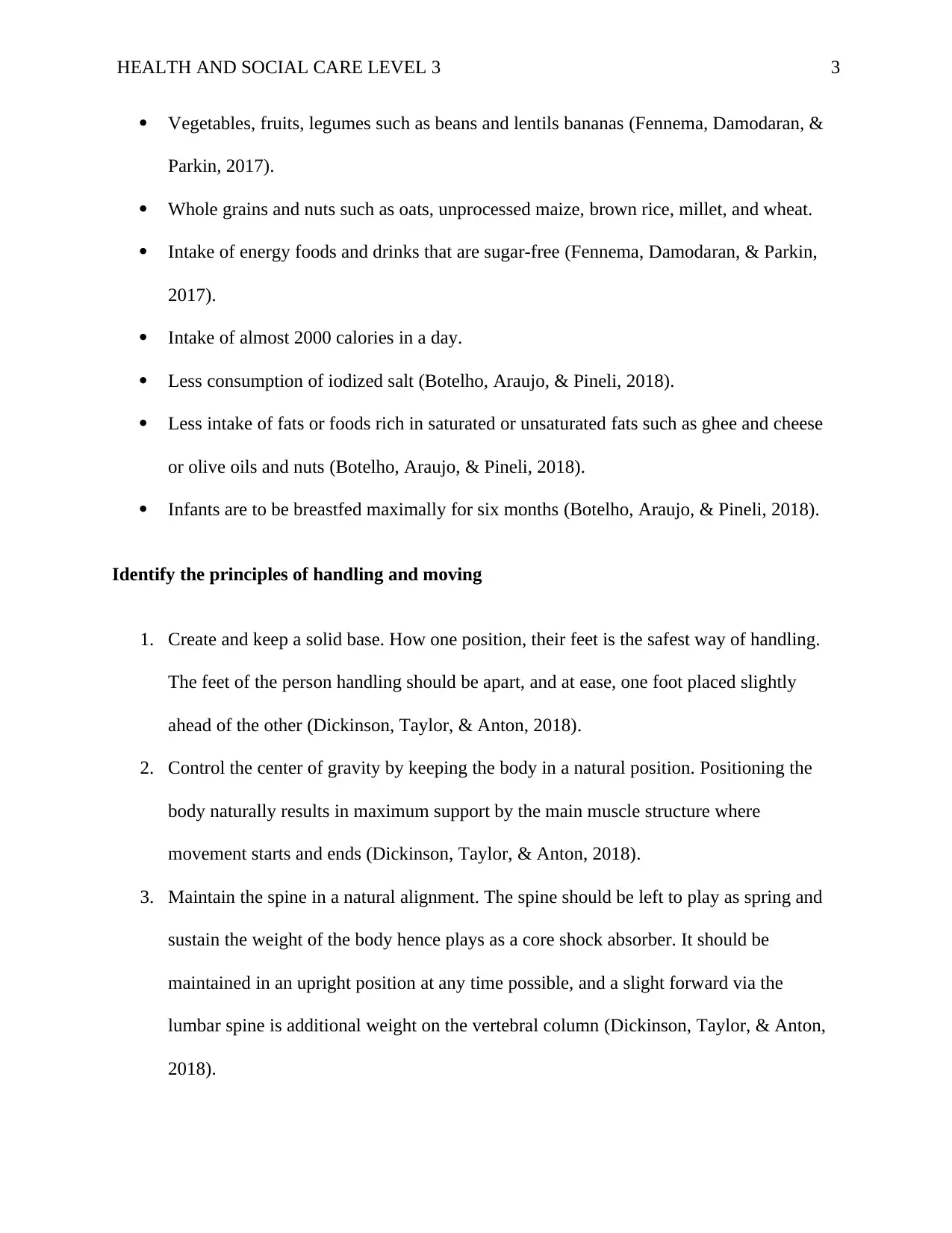
HEALTH AND SOCIAL CARE LEVEL 3 3
Vegetables, fruits, legumes such as beans and lentils bananas (Fennema, Damodaran, &
Parkin, 2017).
Whole grains and nuts such as oats, unprocessed maize, brown rice, millet, and wheat.
Intake of energy foods and drinks that are sugar-free (Fennema, Damodaran, & Parkin,
2017).
Intake of almost 2000 calories in a day.
Less consumption of iodized salt (Botelho, Araujo, & Pineli, 2018).
Less intake of fats or foods rich in saturated or unsaturated fats such as ghee and cheese
or olive oils and nuts (Botelho, Araujo, & Pineli, 2018).
Infants are to be breastfed maximally for six months (Botelho, Araujo, & Pineli, 2018).
Identify the principles of handling and moving
1. Create and keep a solid base. How one position, their feet is the safest way of handling.
The feet of the person handling should be apart, and at ease, one foot placed slightly
ahead of the other (Dickinson, Taylor, & Anton, 2018).
2. Control the center of gravity by keeping the body in a natural position. Positioning the
body naturally results in maximum support by the main muscle structure where
movement starts and ends (Dickinson, Taylor, & Anton, 2018).
3. Maintain the spine in a natural alignment. The spine should be left to play as spring and
sustain the weight of the body hence plays as a core shock absorber. It should be
maintained in an upright position at any time possible, and a slight forward via the
lumbar spine is additional weight on the vertebral column (Dickinson, Taylor, & Anton,
2018).
Vegetables, fruits, legumes such as beans and lentils bananas (Fennema, Damodaran, &
Parkin, 2017).
Whole grains and nuts such as oats, unprocessed maize, brown rice, millet, and wheat.
Intake of energy foods and drinks that are sugar-free (Fennema, Damodaran, & Parkin,
2017).
Intake of almost 2000 calories in a day.
Less consumption of iodized salt (Botelho, Araujo, & Pineli, 2018).
Less intake of fats or foods rich in saturated or unsaturated fats such as ghee and cheese
or olive oils and nuts (Botelho, Araujo, & Pineli, 2018).
Infants are to be breastfed maximally for six months (Botelho, Araujo, & Pineli, 2018).
Identify the principles of handling and moving
1. Create and keep a solid base. How one position, their feet is the safest way of handling.
The feet of the person handling should be apart, and at ease, one foot placed slightly
ahead of the other (Dickinson, Taylor, & Anton, 2018).
2. Control the center of gravity by keeping the body in a natural position. Positioning the
body naturally results in maximum support by the main muscle structure where
movement starts and ends (Dickinson, Taylor, & Anton, 2018).
3. Maintain the spine in a natural alignment. The spine should be left to play as spring and
sustain the weight of the body hence plays as a core shock absorber. It should be
maintained in an upright position at any time possible, and a slight forward via the
lumbar spine is additional weight on the vertebral column (Dickinson, Taylor, & Anton,
2018).
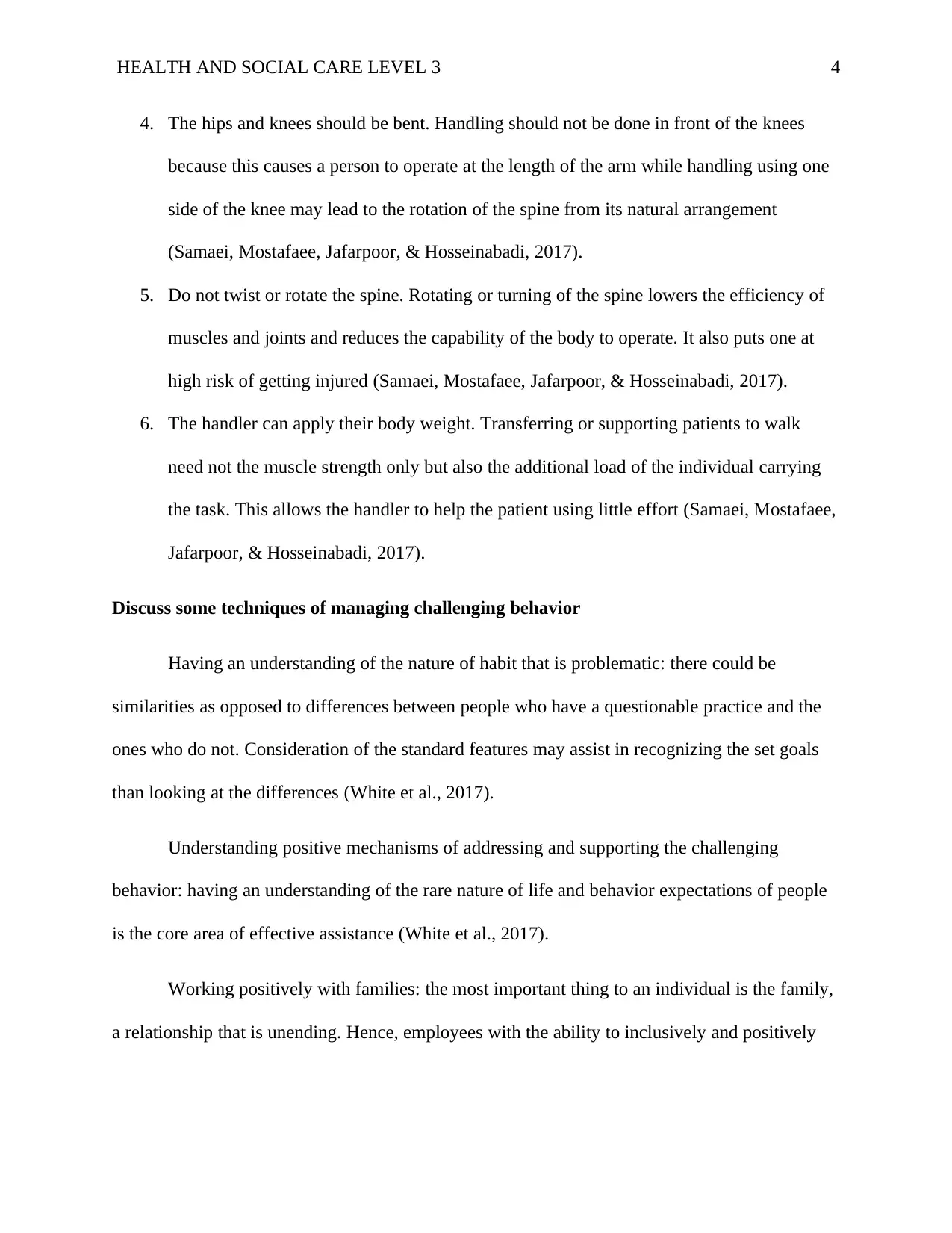
HEALTH AND SOCIAL CARE LEVEL 3 4
4. The hips and knees should be bent. Handling should not be done in front of the knees
because this causes a person to operate at the length of the arm while handling using one
side of the knee may lead to the rotation of the spine from its natural arrangement
(Samaei, Mostafaee, Jafarpoor, & Hosseinabadi, 2017).
5. Do not twist or rotate the spine. Rotating or turning of the spine lowers the efficiency of
muscles and joints and reduces the capability of the body to operate. It also puts one at
high risk of getting injured (Samaei, Mostafaee, Jafarpoor, & Hosseinabadi, 2017).
6. The handler can apply their body weight. Transferring or supporting patients to walk
need not the muscle strength only but also the additional load of the individual carrying
the task. This allows the handler to help the patient using little effort (Samaei, Mostafaee,
Jafarpoor, & Hosseinabadi, 2017).
Discuss some techniques of managing challenging behavior
Having an understanding of the nature of habit that is problematic: there could be
similarities as opposed to differences between people who have a questionable practice and the
ones who do not. Consideration of the standard features may assist in recognizing the set goals
than looking at the differences (White et al., 2017).
Understanding positive mechanisms of addressing and supporting the challenging
behavior: having an understanding of the rare nature of life and behavior expectations of people
is the core area of effective assistance (White et al., 2017).
Working positively with families: the most important thing to an individual is the family,
a relationship that is unending. Hence, employees with the ability to inclusively and positively
4. The hips and knees should be bent. Handling should not be done in front of the knees
because this causes a person to operate at the length of the arm while handling using one
side of the knee may lead to the rotation of the spine from its natural arrangement
(Samaei, Mostafaee, Jafarpoor, & Hosseinabadi, 2017).
5. Do not twist or rotate the spine. Rotating or turning of the spine lowers the efficiency of
muscles and joints and reduces the capability of the body to operate. It also puts one at
high risk of getting injured (Samaei, Mostafaee, Jafarpoor, & Hosseinabadi, 2017).
6. The handler can apply their body weight. Transferring or supporting patients to walk
need not the muscle strength only but also the additional load of the individual carrying
the task. This allows the handler to help the patient using little effort (Samaei, Mostafaee,
Jafarpoor, & Hosseinabadi, 2017).
Discuss some techniques of managing challenging behavior
Having an understanding of the nature of habit that is problematic: there could be
similarities as opposed to differences between people who have a questionable practice and the
ones who do not. Consideration of the standard features may assist in recognizing the set goals
than looking at the differences (White et al., 2017).
Understanding positive mechanisms of addressing and supporting the challenging
behavior: having an understanding of the rare nature of life and behavior expectations of people
is the core area of effective assistance (White et al., 2017).
Working positively with families: the most important thing to an individual is the family,
a relationship that is unending. Hence, employees with the ability to inclusively and positively
Secure Best Marks with AI Grader
Need help grading? Try our AI Grader for instant feedback on your assignments.
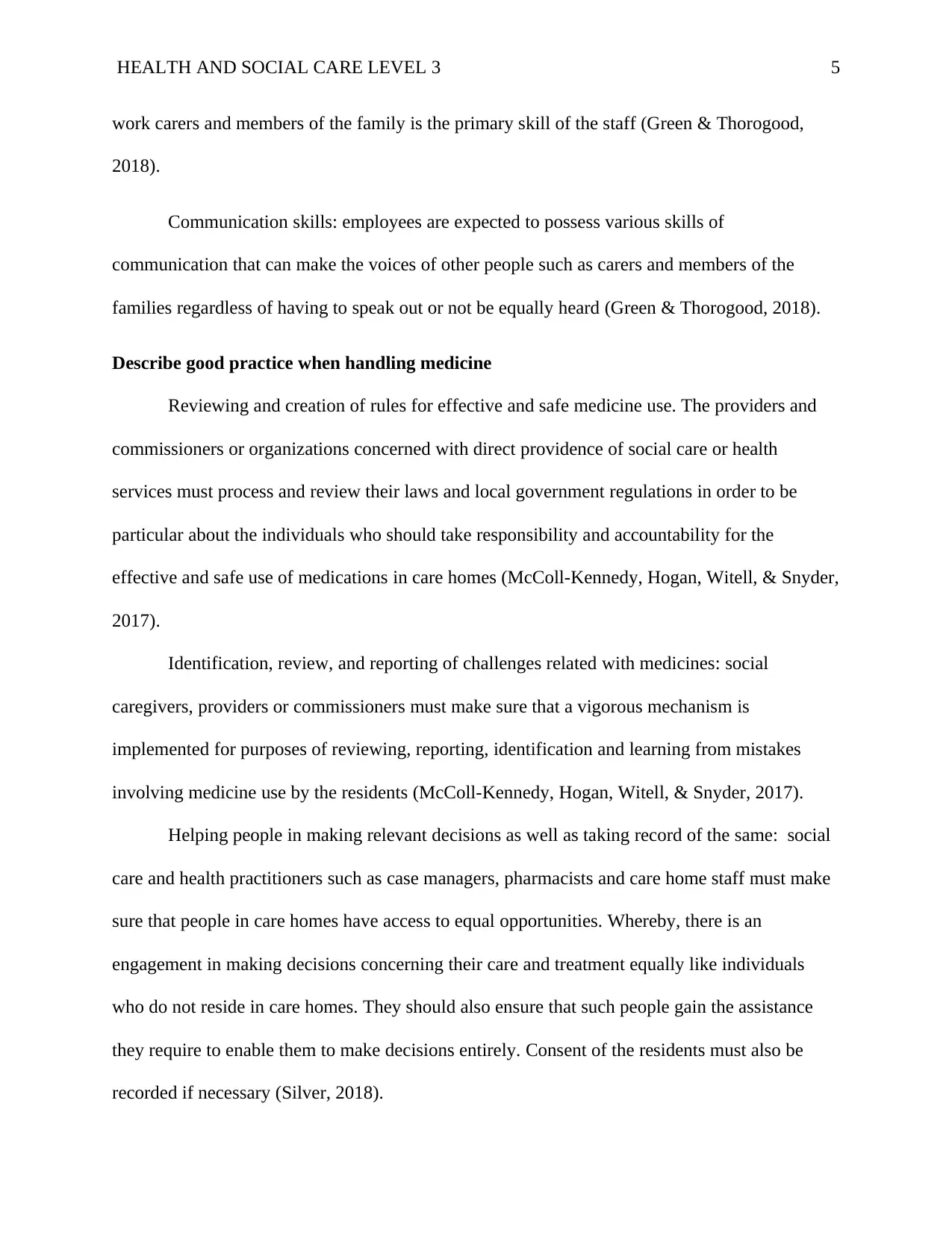
HEALTH AND SOCIAL CARE LEVEL 3 5
work carers and members of the family is the primary skill of the staff (Green & Thorogood,
2018).
Communication skills: employees are expected to possess various skills of
communication that can make the voices of other people such as carers and members of the
families regardless of having to speak out or not be equally heard (Green & Thorogood, 2018).
Describe good practice when handling medicine
Reviewing and creation of rules for effective and safe medicine use. The providers and
commissioners or organizations concerned with direct providence of social care or health
services must process and review their laws and local government regulations in order to be
particular about the individuals who should take responsibility and accountability for the
effective and safe use of medications in care homes (McColl-Kennedy, Hogan, Witell, & Snyder,
2017).
Identification, review, and reporting of challenges related with medicines: social
caregivers, providers or commissioners must make sure that a vigorous mechanism is
implemented for purposes of reviewing, reporting, identification and learning from mistakes
involving medicine use by the residents (McColl-Kennedy, Hogan, Witell, & Snyder, 2017).
Helping people in making relevant decisions as well as taking record of the same: social
care and health practitioners such as case managers, pharmacists and care home staff must make
sure that people in care homes have access to equal opportunities. Whereby, there is an
engagement in making decisions concerning their care and treatment equally like individuals
who do not reside in care homes. They should also ensure that such people gain the assistance
they require to enable them to make decisions entirely. Consent of the residents must also be
recorded if necessary (Silver, 2018).
work carers and members of the family is the primary skill of the staff (Green & Thorogood,
2018).
Communication skills: employees are expected to possess various skills of
communication that can make the voices of other people such as carers and members of the
families regardless of having to speak out or not be equally heard (Green & Thorogood, 2018).
Describe good practice when handling medicine
Reviewing and creation of rules for effective and safe medicine use. The providers and
commissioners or organizations concerned with direct providence of social care or health
services must process and review their laws and local government regulations in order to be
particular about the individuals who should take responsibility and accountability for the
effective and safe use of medications in care homes (McColl-Kennedy, Hogan, Witell, & Snyder,
2017).
Identification, review, and reporting of challenges related with medicines: social
caregivers, providers or commissioners must make sure that a vigorous mechanism is
implemented for purposes of reviewing, reporting, identification and learning from mistakes
involving medicine use by the residents (McColl-Kennedy, Hogan, Witell, & Snyder, 2017).
Helping people in making relevant decisions as well as taking record of the same: social
care and health practitioners such as case managers, pharmacists and care home staff must make
sure that people in care homes have access to equal opportunities. Whereby, there is an
engagement in making decisions concerning their care and treatment equally like individuals
who do not reside in care homes. They should also ensure that such people gain the assistance
they require to enable them to make decisions entirely. Consent of the residents must also be
recorded if necessary (Silver, 2018).
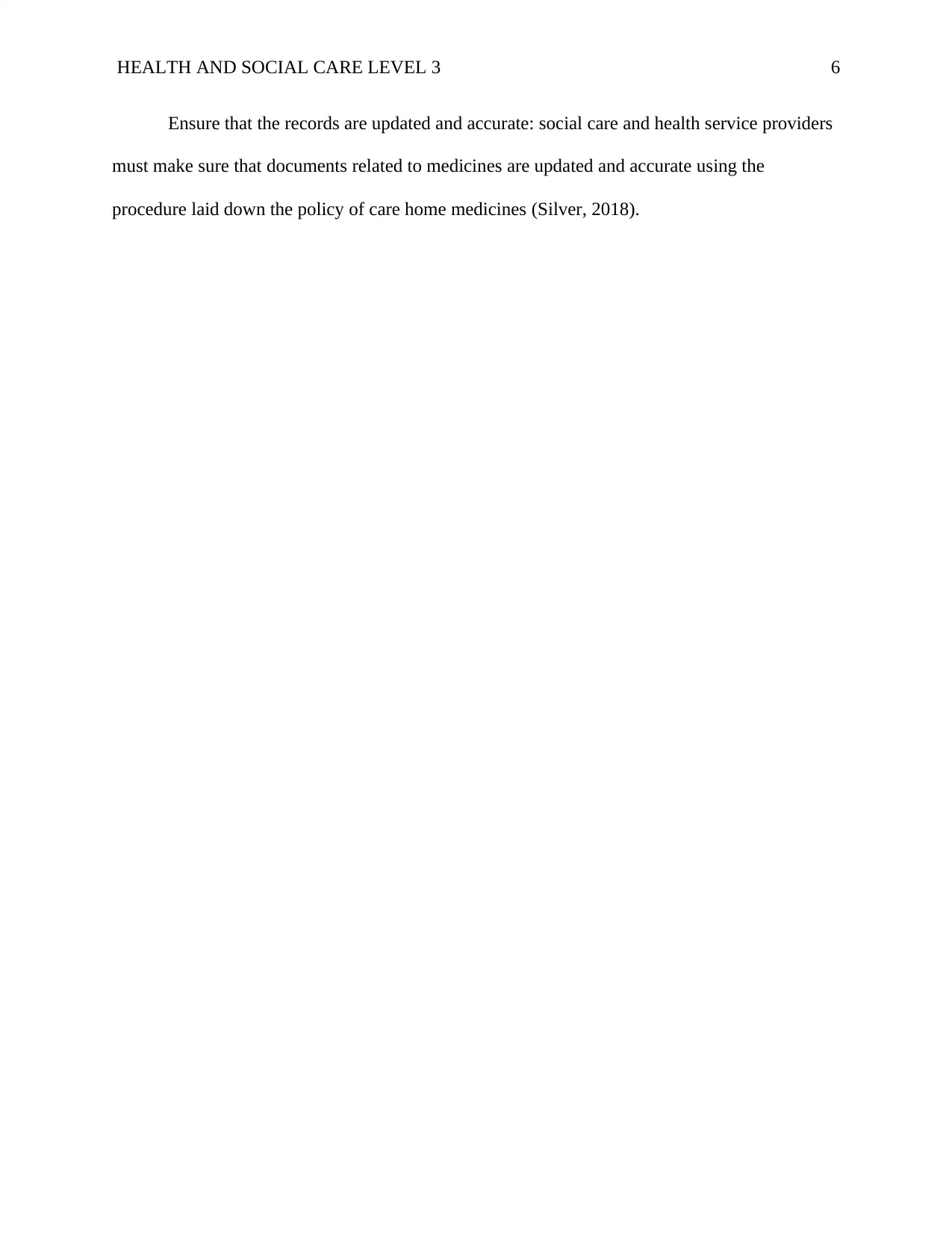
HEALTH AND SOCIAL CARE LEVEL 3 6
Ensure that the records are updated and accurate: social care and health service providers
must make sure that documents related to medicines are updated and accurate using the
procedure laid down the policy of care home medicines (Silver, 2018).
Ensure that the records are updated and accurate: social care and health service providers
must make sure that documents related to medicines are updated and accurate using the
procedure laid down the policy of care home medicines (Silver, 2018).
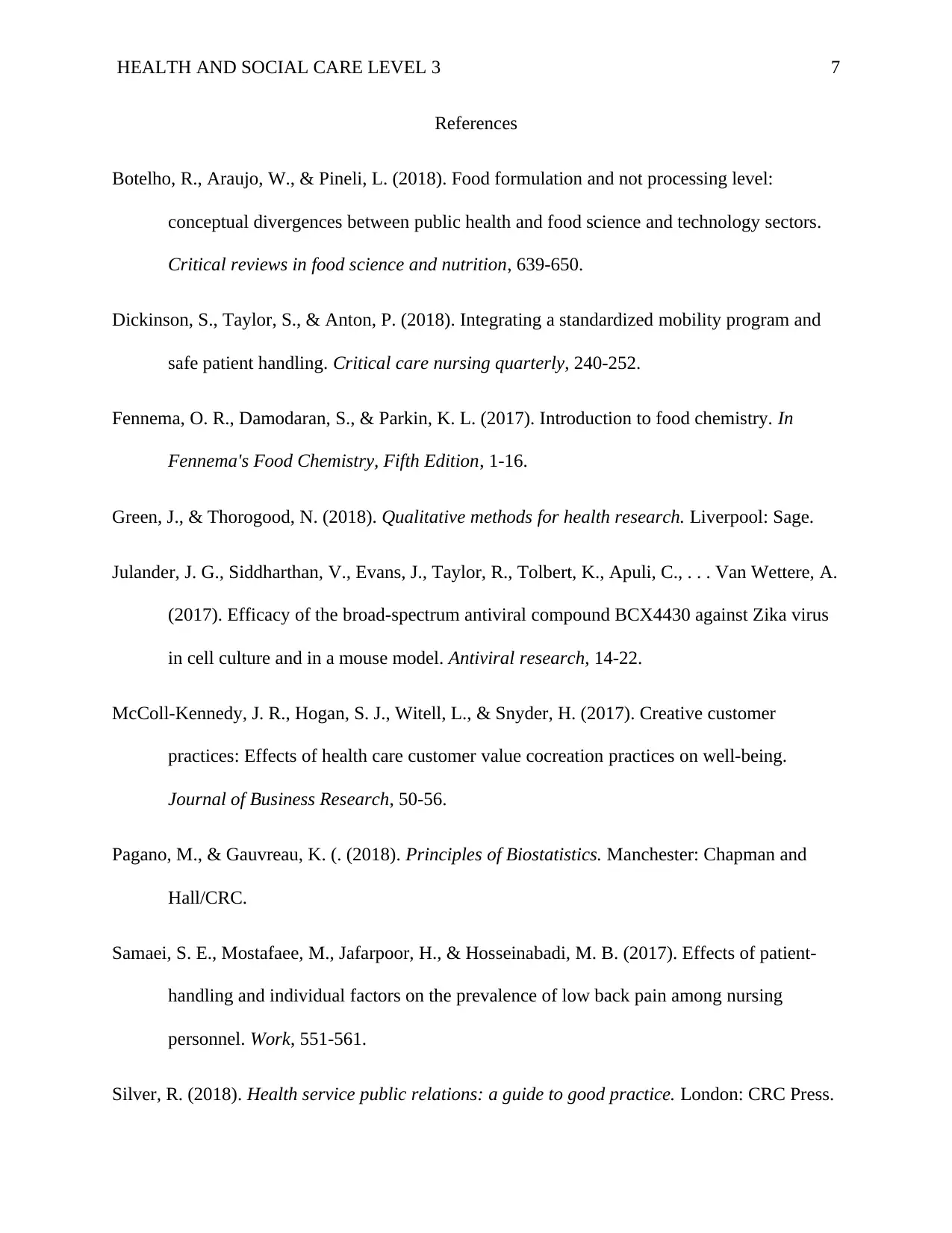
HEALTH AND SOCIAL CARE LEVEL 3 7
References
Botelho, R., Araujo, W., & Pineli, L. (2018). Food formulation and not processing level:
conceptual divergences between public health and food science and technology sectors.
Critical reviews in food science and nutrition, 639-650.
Dickinson, S., Taylor, S., & Anton, P. (2018). Integrating a standardized mobility program and
safe patient handling. Critical care nursing quarterly, 240-252.
Fennema, O. R., Damodaran, S., & Parkin, K. L. (2017). Introduction to food chemistry. In
Fennema's Food Chemistry, Fifth Edition, 1-16.
Green, J., & Thorogood, N. (2018). Qualitative methods for health research. Liverpool: Sage.
Julander, J. G., Siddharthan, V., Evans, J., Taylor, R., Tolbert, K., Apuli, C., . . . Van Wettere, A.
(2017). Efficacy of the broad-spectrum antiviral compound BCX4430 against Zika virus
in cell culture and in a mouse model. Antiviral research, 14-22.
McColl-Kennedy, J. R., Hogan, S. J., Witell, L., & Snyder, H. (2017). Creative customer
practices: Effects of health care customer value cocreation practices on well-being.
Journal of Business Research, 50-56.
Pagano, M., & Gauvreau, K. (. (2018). Principles of Biostatistics. Manchester: Chapman and
Hall/CRC.
Samaei, S. E., Mostafaee, M., Jafarpoor, H., & Hosseinabadi, M. B. (2017). Effects of patient-
handling and individual factors on the prevalence of low back pain among nursing
personnel. Work, 551-561.
Silver, R. (2018). Health service public relations: a guide to good practice. London: CRC Press.
References
Botelho, R., Araujo, W., & Pineli, L. (2018). Food formulation and not processing level:
conceptual divergences between public health and food science and technology sectors.
Critical reviews in food science and nutrition, 639-650.
Dickinson, S., Taylor, S., & Anton, P. (2018). Integrating a standardized mobility program and
safe patient handling. Critical care nursing quarterly, 240-252.
Fennema, O. R., Damodaran, S., & Parkin, K. L. (2017). Introduction to food chemistry. In
Fennema's Food Chemistry, Fifth Edition, 1-16.
Green, J., & Thorogood, N. (2018). Qualitative methods for health research. Liverpool: Sage.
Julander, J. G., Siddharthan, V., Evans, J., Taylor, R., Tolbert, K., Apuli, C., . . . Van Wettere, A.
(2017). Efficacy of the broad-spectrum antiviral compound BCX4430 against Zika virus
in cell culture and in a mouse model. Antiviral research, 14-22.
McColl-Kennedy, J. R., Hogan, S. J., Witell, L., & Snyder, H. (2017). Creative customer
practices: Effects of health care customer value cocreation practices on well-being.
Journal of Business Research, 50-56.
Pagano, M., & Gauvreau, K. (. (2018). Principles of Biostatistics. Manchester: Chapman and
Hall/CRC.
Samaei, S. E., Mostafaee, M., Jafarpoor, H., & Hosseinabadi, M. B. (2017). Effects of patient-
handling and individual factors on the prevalence of low back pain among nursing
personnel. Work, 551-561.
Silver, R. (2018). Health service public relations: a guide to good practice. London: CRC Press.
Paraphrase This Document
Need a fresh take? Get an instant paraphrase of this document with our AI Paraphraser
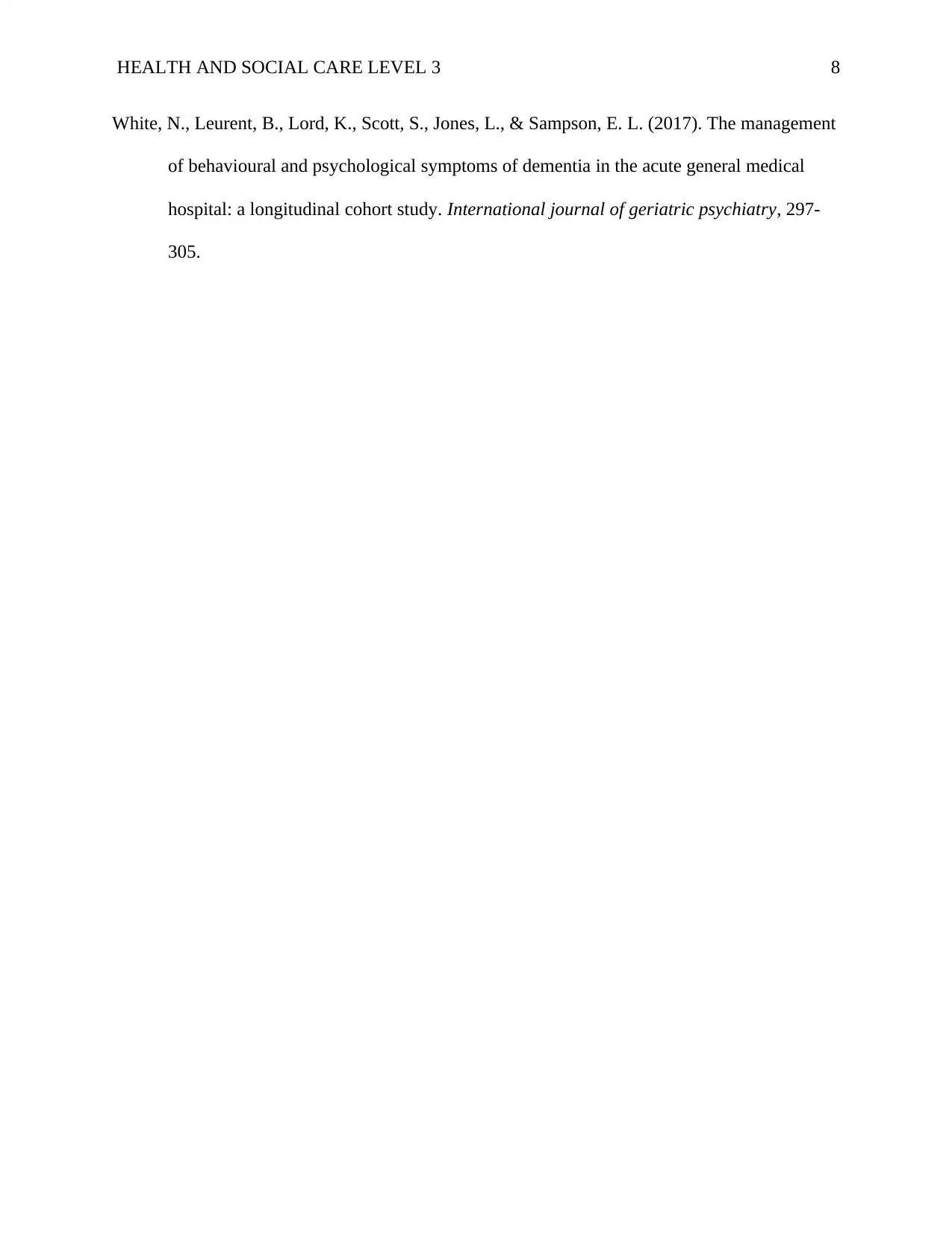
HEALTH AND SOCIAL CARE LEVEL 3 8
White, N., Leurent, B., Lord, K., Scott, S., Jones, L., & Sampson, E. L. (2017). The management
of behavioural and psychological symptoms of dementia in the acute general medical
hospital: a longitudinal cohort study. International journal of geriatric psychiatry, 297-
305.
White, N., Leurent, B., Lord, K., Scott, S., Jones, L., & Sampson, E. L. (2017). The management
of behavioural and psychological symptoms of dementia in the acute general medical
hospital: a longitudinal cohort study. International journal of geriatric psychiatry, 297-
305.
1 out of 8
Your All-in-One AI-Powered Toolkit for Academic Success.
+13062052269
info@desklib.com
Available 24*7 on WhatsApp / Email
![[object Object]](/_next/static/media/star-bottom.7253800d.svg)
Unlock your academic potential
© 2024 | Zucol Services PVT LTD | All rights reserved.